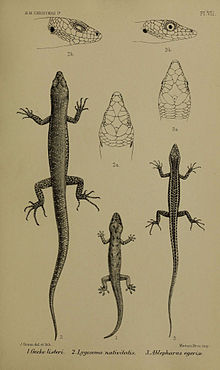Lepidodactylus listeri
| Lister's gecko | |
|---|---|

| |
| L. listeri, figure 1. | |
| Scientific classification | |
| Kingdom: | Animalia |
| Phylum: | Chordata |
| Class: | Reptilia |
| Order: | Squamata |
| Family: | Gekkonidae |
| Genus: | Lepidodactylus |
| Species: | L. listeri
|
| Binomial name | |
| Lepidodactylus listeri (Boulenger,1889)
| |
| Synonyms[2] | |
| |
Lepidodactylus listeri, also known commonly as Lister's gecko or the Christmas Island chained gecko, is a species of gecko, a lizard in the family Gekkonidae, endemic to Christmas Island in the Indian Ocean. It is currently extinct in the wild.
Geographic range[]
L. listeri is endemic to Christmas Island.[3]
Etymology[]
Both the specific name, listeri, and one of the common names, Lister's gecko, are in honour of British naturalist Joseph Jackson Lister.[4]
Description[]
Lister's gecko is a brown lizard growing to a snout-vent length (SVL) of 5 cm (2.0 in). It has a broad, pale fawn/grey vertebral stripe which expands to cover the top of the head and matches the colour and pattern of the tail. It has a whitish belly. The body is covered with small, smooth scales.[5]
Habitat[]
L. listeri is most abundant in primary rainforest on the plateau, but also occurs in disturbed secondary forest growth. It is absent from mined areas on the island.[6][7]
Evolutionary relationships[]
The closest relatives of L. listeri are species of Lepidodactylus belonging to the lugubris group, native to the Mollucas and the Philippines, with the estimated divergence between L. listeri and the lugubris group taking place around 26 million years ago.[8]
See also[]
References[]
- ^ Cogger, H.; Mitchell, N.M.; Woinarski, J.C.Z. (2017). "Lepidodactylus listeri". IUCN Red List of Threatened Species. 2017: e.T11559A83321765. doi:10.2305/IUCN.UK.2017-3.RLTS.T11559A83321765.en. Retrieved 11 November 2021.
- ^ Species Lepidodactylus listeri at The Reptile Database . www.reptile-database.org.
- ^ Brown WC, (1977). "Lizards of the genus Lepidodactylus (Gekkonidae) from the Indo-Australian Archipelago and the islands of the Pacific, with descriptions of new species". Proceedings of the Californian Academy of Sciences, Fourth Series 41 (8): 253-265.
- ^ Beolens, Bo; Watkins, Michael; Grayson, Michael (2011). The Eponym Dictionary of Reptiles. Baltimore: Johns Hopkins University Press. xiii + 296 pp. ISBN 978-1-4214-0135-5. (Lepidodactylus listeri, p. 159).
- ^ Cogger HG (2000). Reptiles and Amphibians of Australia, Sixth Edition. Sydney, Australia: New Holland Books. 808 pp. ISBN 978-1876334338.
- ^ Cogger HG, Sadlier RA (2000). The terrestrial reptiles of Christmas Island - a reappraisal of their status. Sydney: Australian Museum.
- ^ Cogger HG, Cameron EE, Sadlier RA, Eggler P (1993). The Action Plan for Australian Reptiles Archived 14 September 2018 at the Wayback Machine
- ^ Oliver, Paul M.; Blom, Mozes P. K.; Cogger, Harold G.; Fisher, Robert N.; Richmond, Jonathan Q.; Woinarski, John C. Z. (30 June 2018). "Insular biogeographic origins and high phylogenetic distinctiveness for a recently depleted lizard fauna from Christmas Island, Australia". Biology Letters. 14 (6): 20170696. doi:10.1098/rsbl.2017.0696. PMC 6030605. PMID 29899126.
Further reading[]
- Boulenger GA (1889). "On the Reptiles of Christmas Island". Proc. Zool. Soc. London 1888: 534–536. (Gecko listeri, new species, p. 535).
- IUCN Red List extinct in the wild species
- Geckos of Australia
- Fauna of Christmas Island
- Reptiles described in 1889
- Taxa named by George Albert Boulenger
- Lepidodactylus
- Australia stubs
- Gecko stubs
